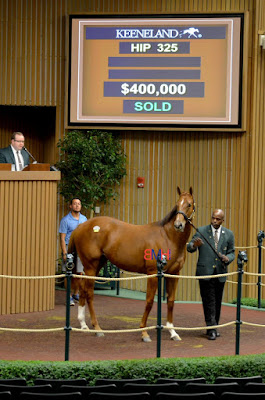Keeping It In the Family: Royal Ascot Pedigree Trends
 |
| The late Scat Daddy had a 100 percent win rate at Royal Ascot |
When 455 horses entered the gate during the 30 races held over the five
days of the 2016 Royal Ascot meet, their owners weren’t the only ones hoping
for wins.
One hundred and seventy-three stallions standing in 19 countries were
represented by at least one runner. While some of those stallions have either
died or pensioned in the years between the time their Royal Ascot entries were conceived
and the 2016 meet, many of the breeders who stand those who are still active were hoping for a good showing at the meet to
add to their stud record.
By the end of the five days, the offspring of 24 stallions got their
picture taken after passing the winning post first.
Standing in six countries, all but three of the winning sires are still active in
the shed. Early in the week the late Scat Daddy and Kodiak looked like they may be able to sneak away
with the leading sire title when they both had two
winners each but in the end, it wasn’t a huge to surprise to see Galileo come
up with four winners on the last two days (it was surprising to see
them come in four consecutive races, however) to take the leading sire title.
Galileo struck at a win rate of 21.7 percent at Royal Ascot with five of
his 23 runners winning. Kodiak had the second highest amount of runners with 15
followed by Dark Angel and Exceed and Excel with 12 each. Scat Daddy, who had
two runners at the meet, had a 100 percent strike rate with Caravaggio and Lady Aurelia
both taking the top prize in their respective 2-year-old races.
 |
| Bernstein's Royal Ascot winner Tepin |
The late U.S. stallion Bernstein and new U.S. stallion Lord Shanakill
were able to copy that 100 percent effort with their single runners winning their
races. Overall, of the countries that currently stand (or stood at the time of
a stallion’s pensioning or death) at least two stallions with Royal Ascot
runners, the U.S. leads with 15.4 percent winners, followed by Turkey with 12.5
percent runners.
It should be noted that one of the six winners coming from stallions
currently standing in the U.S. is by Lord Shanakill, who moved to the U.S. in
2016. The same goes for Turkey’s winner by Bushranger with Bushranger also supplying the country with six runners of its runners. All of them were conceived before he was sold to the country. Without Lord Shanakill’s winner, the U.S.’s
percentage still sits at a country-high 12.8 percent, while Turkey loses its only winner.
Ireland had the most stallions represented by runners with the country’s
stallions siring 203 of the 455 runners (44.6 percent). Those runners supplied 16 winners at
the meet, 10 more than the U.S. had as the runner-up in number of winners and 11
more than stallions standing in England.
Interestingly, the broodmare sires of winners shows just as much
variety as the sires with 25 different winning broodmare sires. Four of
those had two winners each with Galileo and Sadler’s Wells combining for four
winners. Danehill Dancer and Galileo are the only stallions to sire both a
winner and the dam of a winner at the meeting.
Danehill Dancer, Galileo, Giant’s Causeway, Sadler’s Wells and Storm
Cat all had at least one daughter and one son with Royal Ascot winners
while Danehill Dancer, Galileo and Shamardal all sired both a winner and the
sire of a winner at this year’s Royal Ascot meeting.
(Note: Locations used for country stats are based on stallions' last known location while at stud listed by multiple sources)


Comments
Post a Comment